Posted by
Related reading
How to Increase Survey Response Rate - Top Strategies for Success
Boost your survey response rate with these effective strategies. Learn practical tips to engage participants and gather valuable insights. Read more!
The Best Survey Apps for Shopify - Enhance Customer Feedback in 2025
Discover the top survey apps for Shopify to boost customer feedback and improve your store's performance. Read the article to find the best fit for you!
Top 10 NPS Survey Tools to Measure Customer Satisfaction Effectively
Discover the best NPS survey tools to effectively measure customer satisfaction and enhance your feedback strategy. Read this article to find the right fit!

How to Collect and Analyze Customer Feedback - With Examples
Close the feedback loop with our comprehensive step-by-step guide on how to collect actionable customer feedback.
Introduction
You've put in the hard work, and now, your product or service is out there, ready to make the lives of your customers easier. But no matter how good or bad your current product might be, there is always room for improvement, and who better to point you in the right direction than the people using it?
Collecting customer feedback is the secret sauce to making your offering even better. It's like having a conversation with your customers, where they tell you what you are doing right, what's missing, and how you can make their experience top-notch. Pretty awesome, right?
In this article, you will learn why those insights from your customers are invaluable, the best ways to improve response rates, and how to turn customer feedback into the kind of changes that make everyone say, "Wow, they really get me!"
So, let's get into how you can create a customer feedback strategy that lights the way to an even brighter future for your product or service by improving customer happiness.
Why is Collecting Customer Feedback important?
Customer feedback helps because it directly tells you what your customers need and want, as well as what they don't like about your current offerings. This input is invaluable for making informed decisions that improve your products or services.
By listening to your customers, you ensure that you're not just guessing what they might like, but actually tailoring your offerings to meet their real needs and desires. This approach helps you to continually enhance customer satisfaction and make your products or services even better and more aligned with what your customers truly value.
Acting on customer feedback is like custom-tailoring your business strategy to fit your market’s demands, and allows you to show your customers that their voices are heard and valued.
Enhance Product Development
Every piece of customer feedback is a gold nugget of insight into how your product or service can be polished to better address the needs of your market. These insights help you validate your product, by finding out which aspects of your product customers love and which parts might be causing them frustration.
By focusing your development efforts on areas highlighted by your customers, you're not just guessing what might work. Instead, you're making strategic enhancements that are more likely to increase customer satisfaction and contribute to your business's growth.
Improve Customer Satisfaction
There's a simple yet profound truth in the business world: when customers feel heard, they feel valued. We didn’t make this up - Best selling author Dale Carnegie's fundamental theory in 'How to Win Friends and Influence People,' underscores the universal human urge to be recognized and considered important.
By actively listening to your customers and implementing changes based on their feedback, you're tapping into their deep-seated need to feel significant. This acknowledgment transforms passive users into loyal customers by forging a stronger emotional bond with your brand, leading to higher retention rates.
Consequently, these satisfied customers become enthusiastic ambassadors, more likely to spread the word about your exceptional product or service, driven by the genuine connection and importance they feel towards your brand.
Drive Strategic Decisions
Customer feedback often reveals patterns and trends that might not be visible through internal analysis alone. By having this kind of bird's-eye view of the landscape, spotting opportunities and challenges on the horizon suddenly becomes a lot easier.
This perspective is invaluable for guiding your business's strategic decisions, as they allow you to pivot, adapt, and innovate in ways that align with both current and emerging customer needs.
Prepare for Customer Feedback Collection
Alright, so far we have established the importance of customer feedback, but hold your horses. Before beginning to collect customer feedback, it's essential to set clear objectives. What do you hope to learn? Which aspects of your product or service are you looking to improve?
Identifying your target audience and choosing the right timing for your feedback collection are also crucial steps to ensure the effectiveness of your efforts.
Set Clear Objectives
Before you begin collecting customer feedback, you should take a moment to think about what you aim to achieve with this effort. Are you focusing on improving a particular aspect of your product, or are you on the lookout for new opportunities for product development?
Having clear objectives will influence how you collect customer feedback and shape the questions you ask. This clarity ensures that your customer feedback initiative is targeted and effective, and enables you to easily identify the insights that matter most.
Identify Your Target Audience
To gather meaningful feedback, it helps to understand who your customers are, and how you can engage in conversations with different customer segments.
Your customer base is not a monolith but a diverse group with varied needs, preferences, and experiences. Segmenting your audience allows you to focus your customer feedback collection efforts, which results in more relevant and actionable customer insights afterwards.
For example, suppose you're aiming to convert users from a free plan to a paid plan. To achieve this, it's essential to understand precisely what your free users are looking for that they currently aren't getting. What features are they craving? What additional value do they seek? By identifying and focusing on the specific segment of your audience using the free plan, you can craft and distribute targeted surveys or feedback forms that explore their needs and expectations.
This focused approach not only helps you collect valuable insights into what motivates a transition from free to paid but also guides your strategy in enhancing your product or service to meet those desires. Using a tool like Survser for this task can simplify the process, enabling you to seamlessly collect and analyze the feedback necessary to inform your conversion strategies - more on that later.
Choose the Right Timing
The timing of your customer feedback requests can significantly affect the quality and quantity of responses you receive. It's important to consider when your customers are most likely to be receptive and able to provide thoughtful feedback. For digital products, a strategic moment in the customer journey might be right after a user has interacted with a specific feature or completed a particular action.
For example, deploying surveys right after a customer has had a meaningful interaction with your product can yield highly relevant feedback. If your product is digital, there are lots of tools that allow you to display surveys from within your own application, which trigger after a specified user action.
Methods for Gathering Customer Feedback
Now that we covered some important considerations, lets have a look at a few different methods that you can use to gather customer feedback. Each has its own set of benefits and disadvantages, but ultimately share the same objective of better understanding what your customers want from your product.
Customer Surveys and Questionnaires
Feedback Surveys and questionnaires are like the Swiss Army knife of feedback tools—they're versatile and efficient. You can use them to get both the big picture and the fine details.
The benefits of feedback surveys are that they only need to be set up once, and scale easily. However, the drawback is that it can be difficult to follow up on responses, as you are not having a synchronous conversation with the person on the other side. Later in this article, we’ll cover how to design effective feedback survey questions that will leave little space for second guessing.
Depending on how you choose to distribute your surveys, you might also be missing information about who the individual responses are coming from. To solve this issue, you can add a question to your survey that asks the customer about some personal details, or you can use a specialized user research survey solution like Survser, that allows you to automatically attach user information to survey responses.
Interviews and Focus Groups
If the customer feedback survey is the Swiss Army knife, then interviews and focus groups are the scalpel—precise and detailed. By talking directly to your customers, you can get to the heart of what they think and feel. These methods are great for digging deeper into the "why" behind their opinions, with the flexibility to explore new topics that arise during the conversation.
However, customer interviews and focus groups are usually more complicated to organize and are more time intensive for yourself and for your users. Thus, it can be difficult to find volunteers among your customers and you might have to offer an additional incentive for them to participate.
User Testing Sessions
During user testing sessions, you observe customers as they interact with your product. As the moderator, you should remain neutral and try not to influence the participant’s behaviour. By doing so, you can watch your users in their “natural habitat”, and uncover usability issues that might not have been obvious without direct observation.
This method of collecting customer feedback can be really effective, but requires a lot of attention to detail and does not scale well, as these sessions are usually conducted in a One-To-One setting.
Feedback Forms on Websites
Feedback forms on your website or app are the open door inviting your customers to share their thoughts anytime. It's a straightforward way for them to tell you what they think, without waiting for you to ask. This customer feedback channel is usually really easy to implement and won’t take much of your time.
However, it’s difficult to overcome that passive nature of static customer feedback forms, which usually appear outside of any specific context and yield low response rates. Your customers need to be very eager to leave feedback for them to submit it through a feedback form.
Social Media and Online Communities
Social media channels and online communities are the town squares of the internet - places where people freely share their experiences and opinions. By keeping an eye on these platforms, you can gather genuine feedback and engage with your customers in a space where they feel comfortable. It's also a great way to spot trends and see how your offering is being received in the wild.
One key benefit of these channels are that they have potential for broad reach that goes beyond your existing audience, which goes hand in hand with enhanced visibility for your brand.
On the flip side, if you receive negative feedback from unhappy customers, it will be out there for the whole world to see on social media. Managing negative customer feedback can be challenging and offers a vulnerability for your brand’s reputation if not done carefully.
Customer Support Interactions
If your customers experience critical issues with your product, they are likely to reach out to you through your customer support channels. Each of those interactions is a goldmine of insights, as they provide you an opportunity to directly discuss a current issue with the affected customer.
Most of the time, customers reaching out to you about a problem are more likely to take the time to answer follow up questions in great detail, as they need fixing of their problem.
While a new support ticket isn’t inherently positive, you should recognize the learning opportunity that lies behind. Make sure to think about the follow up questions that you ask your customers, and try to reveal the underlying needs and desired that your customer might not have fully articulated.
However, it’s important to strike a balance between subtly extracting more information from the customer, and staying on topic for the issue that the customer is experiencing, so that the person on the other side feels that you are actively working on finding a solution.
Design Effective Surveys and Questionnaires
Okay, you already know a lot about customer feedback at this point, but we haven’t touched on one of the most important points: Designing questions that customers want to respond to, and that will lead you to actionable and relevant customer opinions.
Keep reading to learn how to create clear and consise questionnaires that are geared towards uncovering genuinely useful information that you can use to turn unhappy customers into happy customers.
Create Questions that Maximize Customer Feedback
The art of question design is the key to uncovering actionable feedback from your customers. Let's explore how you can make every question count.
Question Format
Open-ended questions are gold mines for detailed, nuanced feedback, as they allow your customers to freely express themselves. However, they aren't always the right tool for every job. The format of your questions should directly align with your feedback objectives.
For instance, if you are trying to decide which of three features to develop next, an open-ended question might not serve you well. Instead, you'd benefit more from a structured question that lets customers choose from the specific options you're considering. This approach gives you clear, actionable data on customer preferences without leaving room for ambiguity.
That being said, when using open-ended questions, crafting them in a way that encourages easy and thoughtful responses is key. Here's what to consider:
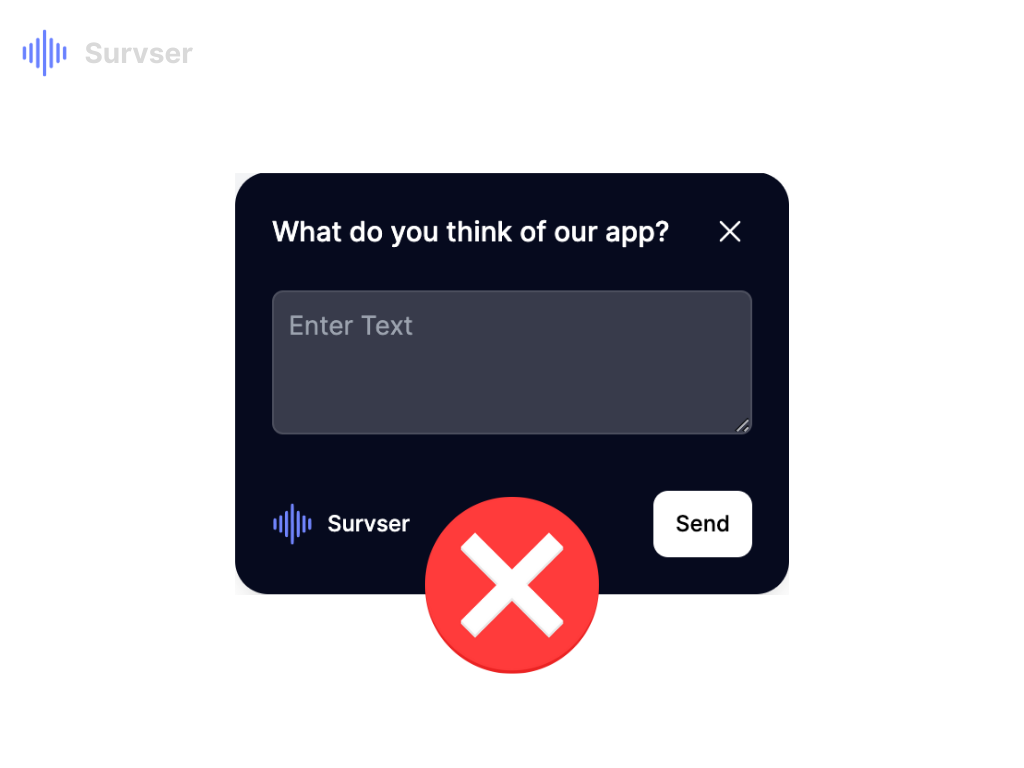
Bad Example: "What do you think of our app?"
This is too broad and vague, making it hard for customers to know where to start. It could overwhelm new customers, or lead to irrelevant feedback.
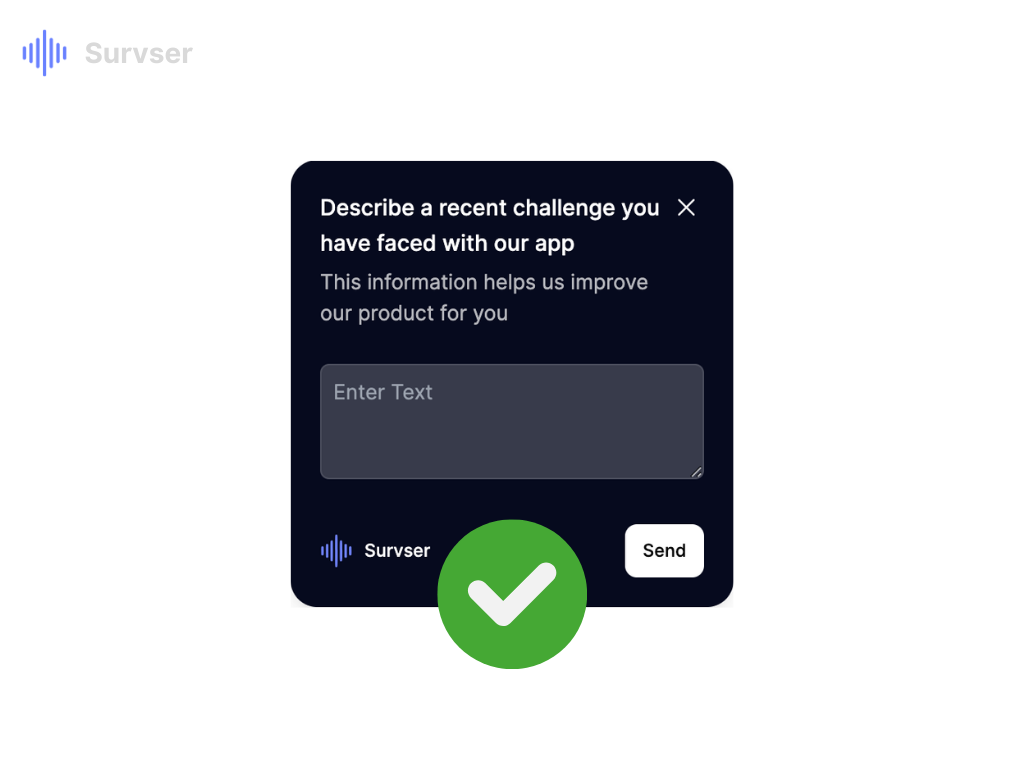
Good Example: "Could you describe any recent challenges you've faced using our app?"
This question invites customers to share their experiences in a structured yet open-ended manner, focusing their responses on a specific aspect of their interaction with your product. Additionally, this question clearly explains what this feedback will be used for.
The balance here is to invite detailed responses without making the task feel like homework. Encourage sharing by framing questions around specific experiences or feelings, making it easier for customers to articulate their thoughts.
The table below shows a comparison of three common question formats that you can use for your customer feedback questions:
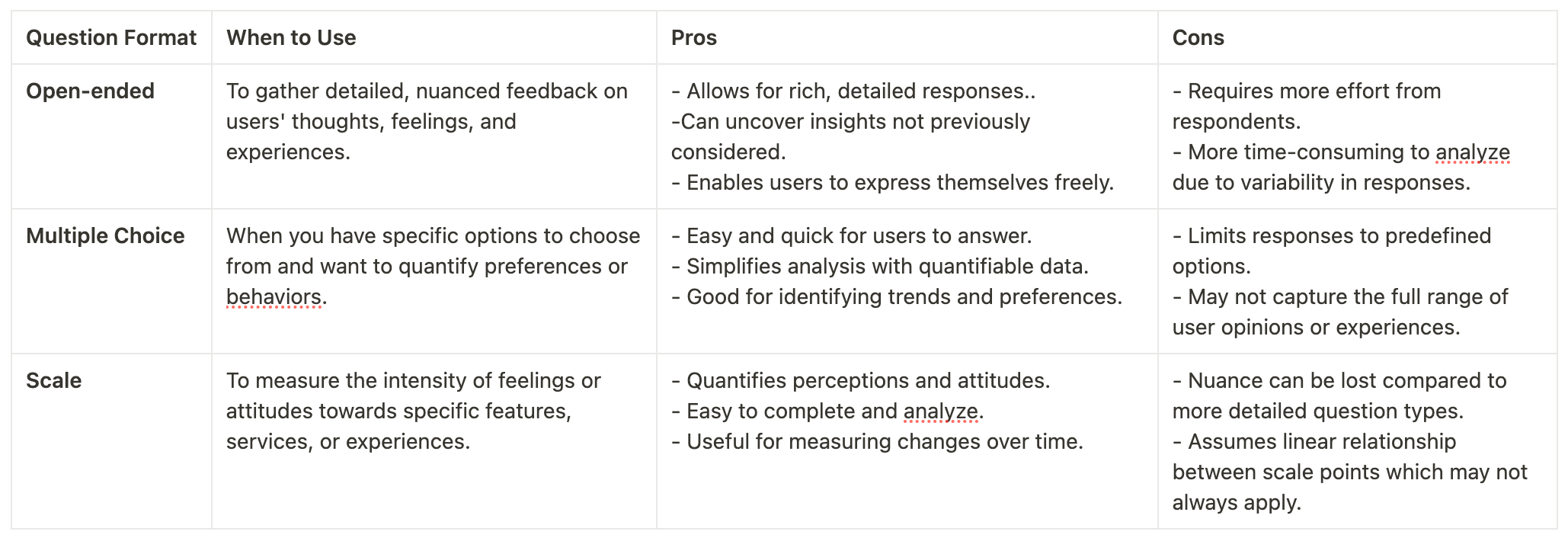
Ask neutral questions
Another important aspect of question design is staying unbiased. Leading questions, or those that hint at a ‘correct’ answer, can distort your data and leave you with insights that reflect your own assumptions, rather than your customers' true experiences.
For example, a question framed as "How much do you love our new feature?" assumes the customer loves it, which could influence their response or discourage honest criticism. Instead, "How has your experience been with our new feature?" allows for a range of genuine responses.
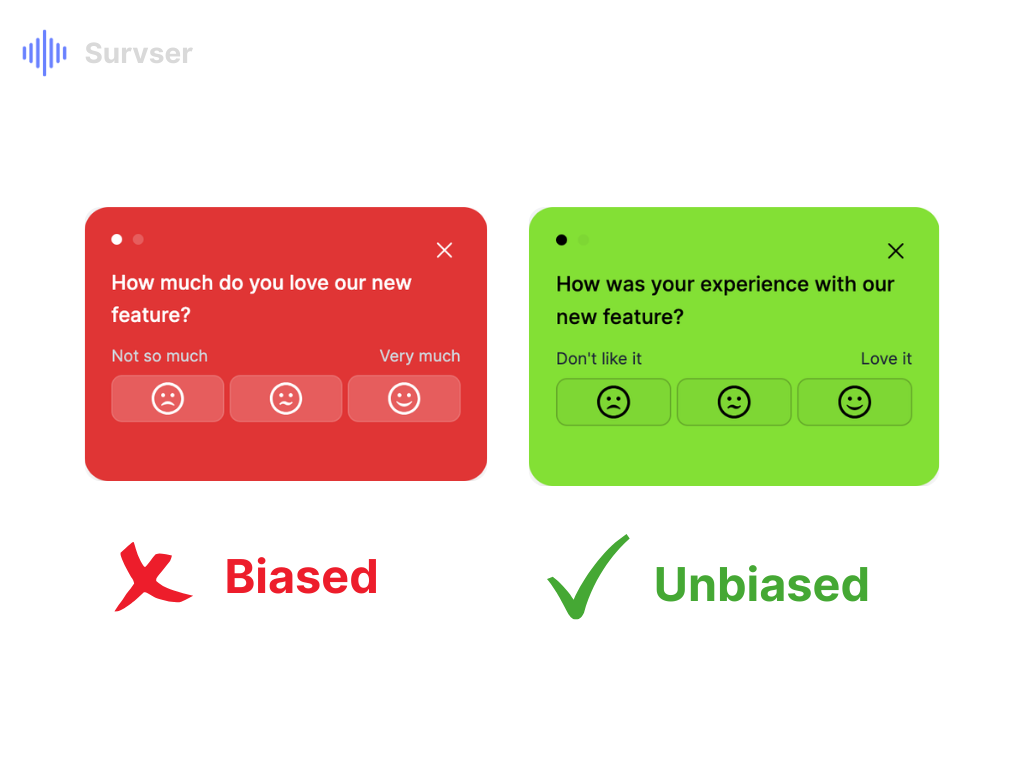
By carefully considering the format of your questions and ensuring they're aligned with your objectives, you are in the perfect position to collect meaningful, actionable feedback. Remember, the goal is to understand your customers' true experiences and opinions, so designing your questions with this in mind will help you unlock the insights you need to make informed decisions.
Choose the Appropriate Format and Length
Your customers' time and attention are very valuable. Once you grab their attention, you don’t want to mess it up. The perfect survey should be detailed enough to gather the insights you need, but concise enough not to demand too much time from your customers. A lengthy survey might lose respondents along the way, while a too-short one might leave you wishing you had more depth in the responses.
Incorporating a mix of question types, such as multiple choice for snappy answers, rating scales for measuring levels of customer satisfaction, and open-ended questions for in-depth feedback, keeps your customer feedback surveys from feeling monotonous. This variety not only engages your customers from start to finish but also equips you with insights from different angles.
Here are some additional points to keep in mind to make your survey truly effective:
- Plan for Multiple Touchpoints: If you foresee the need for ongoing feedback and future interactions with your customers, it's wise to design shorter surveys. This approach increases the likelihood of your customers participating repeatedly over time, keeping the customer feedback loop vibrant and continuous.
- Prioritize Your Questions: When your questionnaire includes several questions, think critically about which ones matter the most. Place the most crucial questions at the beginning of your survey. This way, even if a customer doesn't complete the survey, you've captured the most vital information.
- Clarity on Use of Insights: Be transparent with your customers about how their feedback will be used and the potential benefits for them. Understanding the value of their contribution can motivate customers to share their thoughts. Whether it's improving product features they care about or shaping the future direction of services they use daily, knowing their input has a direct impact can be a powerful incentive to participate.
Your objective should be to make participating in your survey as appealing and straightforward as possible for your customers. Demonstrating that you value their opinions and time increases the chances of their full and honest participation and will provide you with more relevant information.
How to Analyze and Interpret Customer Feedback
Alright, now you already have a pretty solid understanding about different ways to collect customer feedback, and how to design and collect feedback through survey questions that convert into responses. The next step is to roll up your sleeves and act on the collected customer feedback data. This process involves analyzing the responses, and prioritizing the work needed to improve your product offering.
Qualitative vs. Quantitative Feedback
Let’s quickly recap the difference between the two main types of customer feedback.
Qualitative feedback, such as open-ended responses, provides detailed insights into your users' thoughts and feelings. It's the subjective commentary on their experiences, and offers depth and context that numbers alone can't.
Quantitative feedback, like ratings or multiple-choice answers, offers a bird's-eye view of how your product is performing across a wider user base. It's measurable and allows for statistical analysis, giving you a clear indication of trends over time.
Identify Key Insights
Spot Trends and Patterns
The goal here is to move beyond individual pieces of feedback and see the bigger picture. Are there specific features that consistently receive praise or criticism? Are users expressing similar concerns or suggestions?
Try to identify these trends to prioritize areas for improvement but also try to understand what you're doing right. This will help you make informed decisions on how to improve the customer experience.
Understanding Customer Sentiment
Analyzing the emotional tone behind the feedback is just as important as the content itself. Customer sentiment can offer insights into how people feel about your product, which aspects they're passionate about, and what frustrates them.
If you are conducting in-person customer feedback interviews, watch the other person’s body language, which can reveal a lot about how they really feel.
If you chose a digital method of feedback collection, tools that feature sentiment analysis can give you a quick overview of positive, neutral, and negative feedback. This understanding can inform not just product improvements but also guide you on how to communicate with your customers, ensuring your messages resonate with their feelings and experiences.
Prioritize Actionable Insights
Align Insights with Business Goals
Every piece of customer feedback should be evaluated not only for its validity but also for its relevance to your business goals. Ask yourself: Which changes will have the most significant impact on customer satisfaction and retention? How does the feedback align with our product roadmap and business objectives?
This prioritization ensures that your resources are allocated effectively, and that you focus your time on initiatives that offer the highest return on investment.
Create a Prioritization Matrix
A prioritization matrix helps you visually sort feedback based on its importance to your customers and the effort required to implement changes. This can be as simple as a two-axis graph, with one axis representing impact on user satisfaction and the other representing implementation complexity.
Feedback that falls into the high-impact, low-effort area is typically your low-hanging fruit—quick wins that can significantly enhance user experience.
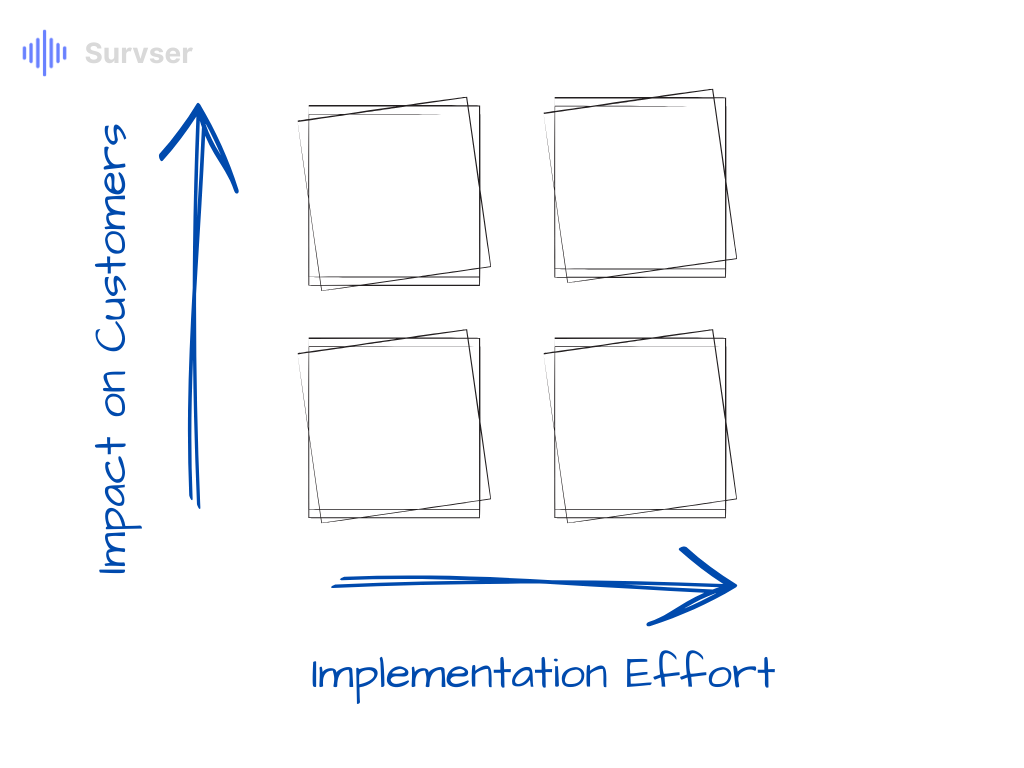
Develop an Action Plan
With your priorities set, it's time to map out how to address the customer feedback. This involves setting clear, actionable steps for each improvement area, assigning team members or, if you are working by yourself, allocating time to work on these changes, and establishing deadlines.
Clear timelines and defined responsibilities are crucial for turning plans into reality. Break down each action item into manageable tasks, assign them to specific team members or block a time in your calendar to address them, and set realistic deadlines.
Close the Feedback Loop
One of the most important yet often overlooked steps in the feedback process is closing the customer feedback loop with your customers. Update them on the changes made in response to their feedback.
This communication can be through social media, email updates, blog posts, in-app notifications or even personal outreach. It shows that you value their input and are committed to enhancing their experience, which will result in a stronger relationship and encourages ongoing feedback.
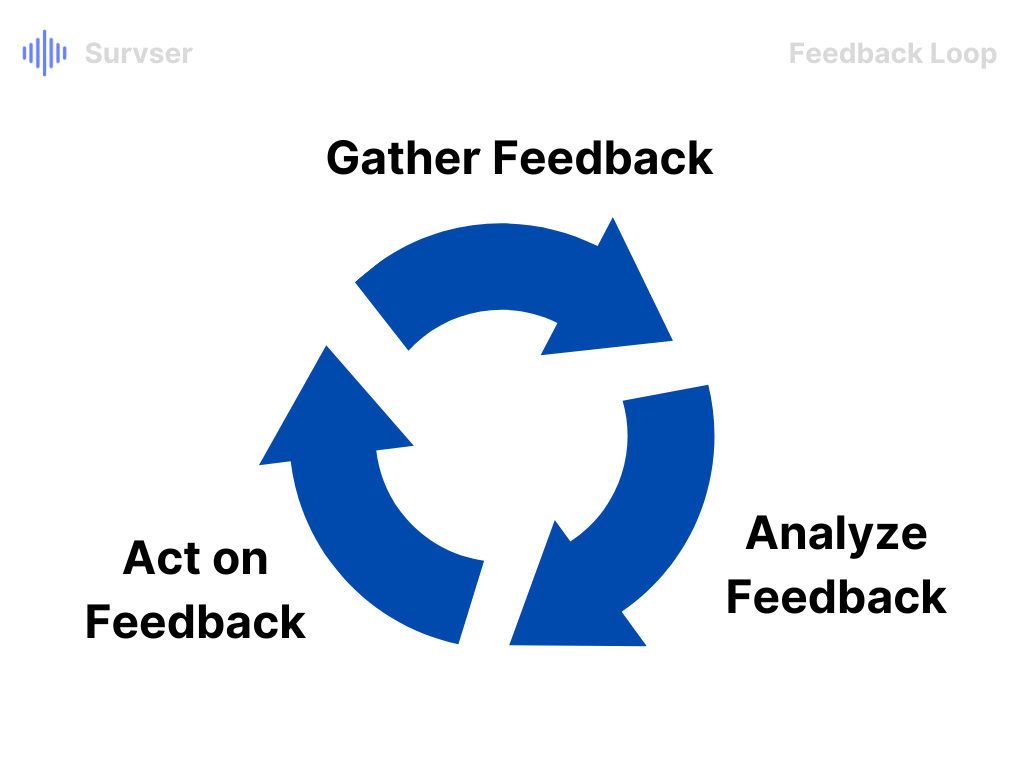
Measure Impact of Implemented Changes
Finally, assess the effectiveness of the changes you've made. Gather new feedback to see how customers are responding to the updates. Are customer satisfaction levels improving? Are you seeing higher engagement or retention rates? This ongoing evaluation will validate your efforts and helps you make decisions on future iterations, ensuring your product continuously evolves in alignment with customer needs.
Customer Feedback Tools
In today's digital age, gathering customer feedback has become more streamlined and efficient, thanks to a variety of tools and technologies at our disposal. From collecting direct customer input to understanding customer behavior indirectly, these tools can significantly enhance how you interpret and act on customer feedback.
Customer Survey Tools and Platforms
As previously addressed, specialized survey tools are great and low-effort solutions for gathering direct customer feedback. They allow you to create surveys for all imaginable use cases, distribute them across multiple channels, and analyze the responses systematically. With features like diverse question types, templates, and analytics capabilities, these platforms make it easy to design surveys that engage users and provide meaningful insights.
Survser: In-App Surveys at an unbeatable price
At this point, let us take a moment to introduce Survser. It stands out as an easy and affordable solution for digital products that allows you to easily integrate in-app surveys with your own product.
Survser offers flexible survey triggers that enable you to engage users at just the right moments, without disrupting their natural user flow. Survser also makes feedback analysis a breeze, with easy to understand visualizations and more analytics features that you’ll love. If you are ready to get started with your user feedback endeavour, give it a try and start for free.
Analytics and User Behavior Tracking
Beyond direct surveys, understanding how customers interact with your product can offer invaluable insights. Analytics and user behavior tracking tools provide a window into the customer journey through your product, highlighting areas of friction, drop-offs, and engagement.
These tools collect data on user actions, such as clicks, scrolls, and time spent on pages, allowing you to pinpoint where improvements are needed. By analyzing this passive feedback, you can make data-driven decisions that enhance the customer experience and address issues before they become major pain points. Some tools you might consider include:
AI and Machine Learning for Customer Feedback Analysis
If you are collecting customer feedback at a larger scale, the volume of collected data can become overwhelming, but AI and machine learning technologies are changing the game.
These tools can sift through vast amounts of data, identifying patterns, sentiments, and trends that you might otherwise miss. By leveraging AI, you can automate the categorization of customer feedback, customer sentiment analysis, and even prediction of customer satisfaction based on various factors.
This not only saves time but also ensures that your decisions are backed by comprehensive data analysis. AI and machine learning can help prioritize customer feedback based on its predicted impact, allowing you to focus on making changes that will most positively affect customer satisfaction and business outcomes.
By leveraging these tools and technologies, businesses can transform the way they collect, analyze, and act on customer feedback. Whether through direct surveys, passive behavior tracking, or advanced AI analysis, the goal remains the same: to understand and improve the customer experience based on real, actionable insights.
Conclusion
Congratulations on making it through the comprehensive guide to mastering customer feedback! By now, you're equipped with the knowledge to gather, analyze, and act upon customer feedback in ways that can significantly transform your business.
Remember that your customers opinions are the key element to improving your offering and that their feedback is more than just a resource. It helps you fine-tune your product, innovate, and stay ahead of the curve. By implementing the strategies and leveraging the tools discussed, you're setting the stage for a product that continues to evolve and meets your users’ needs.
Keep the customer feedback loop spinning, stay responsive to your customers' needs, and watch as your business and customer loyalty grow hand in hand.
Frequently Asked Questions
How often should I gather customer feedback?
Collecting customer feedback should be an ongoing process, but the frequency can vary based on your project's stage and the nature of insights you are looking for. For ongoing operations, aiming for a structured feedback collection once every quarter might suffice. However, after launching new features or making significant changes, it's wise to gather feedback more immediately to understand customer reactions.
How to handle negative customer feedback?
Approach negative feedback with an open mind and a problem-solving attitude. First, acknowledge the feedback promptly and thank the customer for sharing their thoughts. Investigate the issue thoroughly and determine its root cause.
If it's a valid concern, outline steps for resolution and communicate these back to the customer. Use both good and bad feedback as a learning opportunity to refine your product or improve customer service, and prevent similar issues in the future.
How can I encourage more customers to provide feedback?
To encourage more customers to provide feedback, make the process as frictionless as possible. Use direct and engaging questions, and offer multiple digital channels for feedback collection, such as in-app surveys, emails, or social media.
Providing incentives can also motivate customers, whether it's access to beta features, discounts, or entry into a prize draw. Most importantly, show customers that their feedback leads to real changes; this establishes trust and motivates further participation.
How to close the feedback loop with customers?
Closing the customer feedback loop involves informing your customers about how their input has been used to make changes or improvements. This can be done through follow-up emails, announcements about product updates, in-app notifications, or social media posts. Personalized responses to individual feedback can also make users feel valued and heard.
How to design questions for customer feedback?
Designing questions for customer feedback starts with being clear about what information you're looking for. Use a mix of open-ended questions for qualitative insights and closed-ended questions for quantitative data.
Ensure questions are neutral and avoid leading language. For open-ended questions, encourage detailed responses by asking "why" or "how."
For closed-ended questions, provide a balanced range of response options. Keep your survey or feedback form concise to respect your customers' time, and consider testing your questions with a small group to ensure they're understood as intended.
How to prioritize customer feedback?
Prioritizing customer feedback involves evaluating the impact of each piece of feedback on your customer experience and business objectives. Start by categorizing feedback into themes or issues. Then, assess each category based on its urgency, the number of customers affected, and its potential to improve customer satisfaction or meet strategic goals.
Use a prioritization matrix to visually organize feedback by impact and feasibility. Focus on quick wins and high-impact changes first, but also plan for addressing lower-priority feedback in your product roadmap.
What is a customer feedback strategy?
A customer feedback strategy is a structured approach designed to systematically gather, analyze, and act upon feedback from your customers. It includes defining clear objectives for why you're collecting feedback, deciding on the methods and tools you'll use to collect it, and determining how you'll analyze the data to extract actionable insights.
A well-crafted feedback strategy also includes plans for how you'll implement changes based on feedback and communicate those changes back to customers, closing the customer feedback loop.